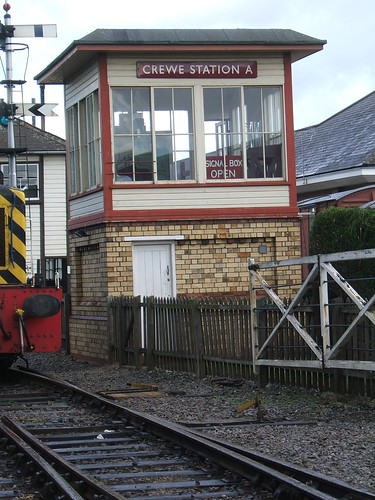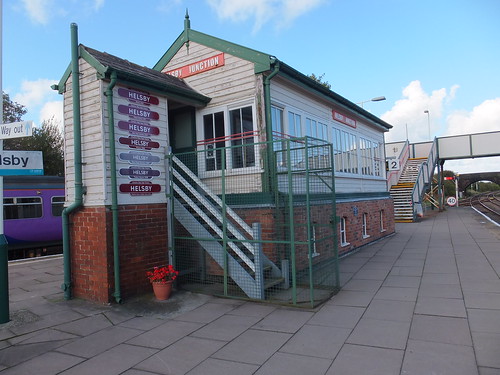 LNWR 'composite' signal box at Market Bosworth, under restoration in 2013.
LNWR 'composite' signal box at Market Bosworth, under restoration in 2013.
In the post Visiting Signalboxes I described the start of my interest in railway signalling.
In my post The London and North Western Railway, I mentioned the signals and signal boxes introduced by the prolific designer Francis William Webb for the LNWR. There's a little about signals in the post L&NWR Signalling and the 'Bedstead'.
The Building
In the early days of railway signalling, safety was largely dependent upon what the signalman could see, so signal boxes normally had an elevated operating floor to improve the signalman's view of the lines he controlled. The operating floor was usually generously provided with windows, producing a 'greenhouse' appearance. Some of these windows were arranged to open so that the signalman had an unimpaired view. Some railways used one of the railway signalling contractors to supply signal boxes and signalling equipment, others carried out the work 'in-house'.
The LNWR originally used outside contractors but Webb believed that manufacturing in-house led to highest quality and lowest cost to the railway so distinctive LNWR signal box designs were produced, assembled from common parts. The upper operating floor and roof were timber-framed, the lower section (usually termed the 'locking room') could be either wooden or brick, depending upon the site. Where a brick lower section was provided, the height could vary according to the site. For more details, refer to Richard Foster's excellent book [reference 1].
The LNWR was uncharacteristically generous in the provision of opening casements on the operating floor. These were arranged to slide on a rather crude metal rail and, when closed, a thumbscrew with a square thread form was provided to secure the casement closed. But usually, even when closed, windows were a source of draught, as were the slots to allow the levers to be moved. In my post Life in the Signal Box, there's a section titled Heating Signalboxes which deals with this. Needless to say, the LNWR also produced its own cast iron stoves for use in signalboxes in-house.
Crewe Heritage Centre is home to the preserved Crewe Station 'A' Box. There's more about the LNWR signal boxes at Crewe in the post Crewe Station Signal Boxes. Although this example is a little unusual (having a flat-roof because it was situated beneath the All-over roofing of the station, had an electric rather than mechanical frame of the 'Crewe' All Electric pattern and with a non-standard brick base to match the brickwork of the station itself), it still uses elements common to most LNWR boxes.

Crewe Station 'A' Signal Box, as preserved at Crewe Heritage Centre.
Security of Signalboxes
Signal box security remained very simple back at least up to the 1960s. LNWR boxes had a very simple door handle and latch made from a few standard castings which incorporated a screw-down 'lock' requiring only a simple forked key which was common to all boxes. It was so crude, I made my own key out of an old poker. And yet, vandalism didn't seem a major problem then unless the box had remained 'switched out' and unattended for a length of time.
When boxes were staffed, you could just walk in but nowadays lockable 'cages' are being provided around the access steps. Helsby was the first box I'd seen with this feature but it is being introduced more widely. In my post Ellesmere Port - Helsby line, I mused that "this might be to protect the public from a particularly violent breed of signalmen but I'm sure it's actually to protect signalmen from enraged passengers ('customers'?) when they despair of getting to their destination".
 Helsby modernised LNWR signal box with 'cage'.
Helsby modernised LNWR signal box with 'cage'.
In my post The Holyhead to Crewe Railway Line, there are (not very good) pictures I took of the signal boxes which survive between Holyhead and Crewe. Many of these are LNWR-built boxes, with varying degrees of modernisation (dual glazed UPVC windows are the most common change). The post By Rail to Manchester has a few 'snatched' pictures of LNWR boxes and there are other pictures scattered around my railway posts - I must try to collect then into an album.
Other websites
The Signal Box site has many signal box pictures, plus links to similar resources.
Signalling Record Society is an indispensible source of information.
Book references
[1] 'A Pictorial Record of L.N.W.R. Signalling' by Richard D. Foster (Oxford Publishing Company 1982) SBN: 86093 147 1.
[2] ‘A Pictorial Record of L.M.S. Signals’ by L. G. Warburton with V. R. Anderson (Oxford Publishing Company 1972) SBN 902888 09 9.
[3] ‘The Signal Box – A Pictorial History and Guide to Designs’ by the Signalling Study Group (Oxford Publishing Company 1986) ISBN 0-86093-224-9.
